Fruit and vegetable wastes (FVW) is a collective term that includes peels, pomace, membranes, seeds and placenta of the fruit and vegetable items. Peels/pomace are generally considered as waste materials and large amount of these are discarded from food processing workshops, every year as industry leftover. It is estimated that 50 million ton FVW are generated in each year in India alone. Further, the quanta of FVW output across the globe is quite worrisome – 1.3 billion metric ton (FAO, 2014). These waste materials may greatly pollute the environment if not recycled judiciously. Most interestingly, these wastes have the true potential to increase the productivity of farm animals if supplemented strategically (Sagar et al., 2018). FVW contain wide array of polyphenol compounds reported to reduce oxidative stress through orchestrated metabolic pathways and thereby increase the immunity and productivity of the farm animals.
Common fruit and vegetable wastes used for livestock feeding
Utilization of fruit and vegetable wastes as animal feed supplement showed great promise in different trials (Wadhwa and Bakshi, 2013) across the globe. Table 1 shows bioactive substances present in different fruit and vegetable wastes. Due to presence of plethora of beneficial polyphenols with potential health benefits, tomato pomace may be used as low-cost additive in poultry feed. Yitbarek (2013) showed that dried tomato pomace inclusion in the poultry feed produced higher economic return compared to control group. Consumers generally prefer eggs with dark red colored yolks. Salajegheh et al., (2012) reported that inclusion of dried tomato pomace significantly increased yolk color score. Thus, chicken producers can be economically benefitted if they can incorporate dried tomato pomace in poultry feed. Empty green pea pod is another important vegetable waste from frozen pea industry, and this could be safely included in ruminant feed (Wadhwa et al., 2017) without any harmful effect on milk yield. Carrot tops are available as processing wastes from prickle industry and an excellent source of β-carotene. Venkataramanan et al., (2015) advocated feeding of carrot tops to ruminants as feed blocks. Plenty beta carotene levels in carrot tops would act as source of vitamin A which is highly needed in pregnant animals and calves. Potato peel wastes, collected from potato chip production plants, contain good quantity of starch, cellulose and fermentable sugars apart from potent phenolic acids with antioxidant roles. This excellent waste could be fed to dairy cattle @ 10-15 kg per day without any deleterious effect on milk yield or overall health.
|
Table 1. Bioactive roles of common fruit and vegetable wastes |
|||||
| SN | Name of FVW | Source | Major Polyphenols | Bioactive roles | References |
|
Vegetable Processing Wastes |
|||||
| 1 | Tomato pomace | Tomato ketchup industry | Lycopene, gallic acid | Antioxidant, Antidiabetic, Anticarcinogenic | 1 |
| 2 | Beet root peel | Snacks centres/ Restaurants | Betalains | Antioxidant, Anticancer, Hypolipidaemic, Cardioprotective | 3 |
| 3 | Empty Green pea pod | Frozen pea processing industry | ∞ carotene, Ferulic acid | Antioxidant,
Anticancer |
10 |
| 4 | Carrot tops | Prickle industry | β carotene | Formation of vitamin A, Protection of skin and vision | 2 |
| 5 | Pumpkin strands and seeds | Prickle industry | Lutein, Caffeic Acid, Rutin | Antioxidant, Protection of vision, Neuro protective | 2 |
| 6 | Potato peel | Potato chips industry | Ferulic acid, Chlorogenic acid | Antioxidant, Anti-inflammatory, Antihypertensive | 8 |
|
Fruit Processing wastes |
|||||
| 1 | Orange peel/pulp | Beverage industry | Naringin, Kaempherol | Antioxidant, Anti -inflammatory | 6 |
| 2 | Pomegranate peel | Juice/squash processing centres | Gallic acid, Ellagic acid, Punicalgin | Antioxidant Anticancer Neuro protection | 6 |
| 3 | Ripe Mango peel | Juice/squash processing centres | Quercetin, Mangiferin, Ellagic acid | Antioxidant Neuro protection Hypolipidaemic Cardioprotective | 9 |
Pomegranate is an ancient fruit, native to Asia and its peel is endowed with potent phenolic acids with diverse bioactive roles. Pomegranate peel may act as additive in broiler diet. Recent research (Ghosh et al., 2020) showed that aqueous infusion of pomegranate peel in drinking water induced better weight gain and feed conversion ratio in broiler chicks. It was further observed that upon application of pomegranate peel infusion in drinking water, antioxidant capacity of broiler meat was significantly increased, thereby enhancing meat self-life. Fruit peels or pulps contain much more dietary polyphenols than vegetable peels. Dried orange pulp contains soluble carbohydrates and rich in polyphenols. It was observed that dried orange pulp can replace 20 % of concentrate in dairy cattle ration without adversely affecting milk yield and rumen metabolites.
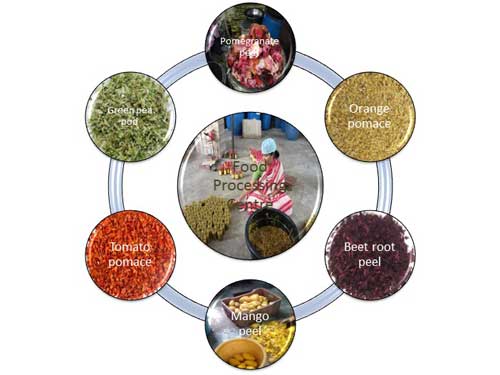
Not only dried pulp, orange peels also hold promise as animal feed additive. Recent research (Ebrahimi et al., 2013) showed that diet containing 1.5% dried sweet orange peel can improve feed intake and body weight in broiler chickens. Similarly, ripe mango peels are rich in fiber and bioactive flavonoids. Due to presence of sugar, the mango peels are also highly palatable and can be mixed with rice straws to augment more milk production in dairy cows.
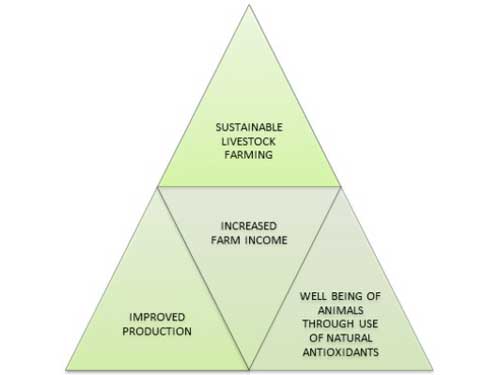
Conclusion
Recent studies throw light on enormous potential of fruit and vegetable wastes, which is remain under-utilized in animal feed additive sector till now. Different kinds of fruit and vegetable wastes can be processed to make readymade additive, either by simply making it powder through drying and grinding or using infusion or percolation techniques. Whatever may be the end-product from FVW – a powder or liquid, it would surely boost up productivity in livestock if supplemented regularly with feed or with drinking water. Even small or medium sized livestock farm-owners might produce the supplement from FVW as their additional enterprises and thereby increase the farm production sustainably by natural supplements. Sustainable livestock farming is possible through judicious use of FVW (Fig 2). A new vista of economic empowerment of small and medium sized farmers can be envisaged if true potential of FVW in livestock sector can be harnessed with scientific approach.
References
- Abbasi-Parizad, P., De Nisi, P., Adani, F., Pepé Sciarria, T., Squillace, P., Scarafoni, A., Iametti, S., & Scaglia, B. (2020). Antioxidant and Anti-Inflammatory Activities of the Crude Extracts of Raw and Fermented Tomato Pomace and Their Correlations with Aglycate-Polyphenols. Antioxidants (Basel, Switzerland), 9(2): 179. https://doi.org/10.3390/antiox9020179
- Amengual J. (2019). Bioactive Properties of Carotenoids in Human Health. Nutrients, 11(10), 2388. https://doi.org/10.3390/nu11102388
- Choo W.S. (2018) Betalains: Application in Functional Foods. In: Mérillon JM., Ramawat K. (eds) Bioactive Molecules in Food. Reference Series in Phytochemistry. Springer, Cham. https://doi.org/10.1007/978-3-319-54528-8_38-2
- Ebrahimi, Abbas & Qotbi, Ali & Seidavi, Alireza & Laudadio, Vito & Tufarelli, Vincenzo. (2013). Effect of different levels of dried sweet orange (Citrus sinensis) peel on broiler chickens growth performance. Archiv fur Tierzucht. 56. 11-17. 10.7482/0003-9438-56-002.
- FAO. (2014). Definitional framework of food losses and waste. Rome, Italy: FAO.
- Ghosh Sarbaswarup, Chatterjee Jayanta Kumar, Hazra Alok Kumar. (2019). Comparative evaluation of in vitro antioxidant activities and high-performance liquid chromatography fingerprinting of fruit peels collected from food processing industry wastes. Pharmacognosy Research. 11(4): 346-351
- Ghosh, S., Chatterjee, P.N., Maity, A., Mukherjee J., Batabyal S., Chatterjee JK. (2020). Effect of supplementing pomegranate peel infusion on body growth, feed efficiency, biochemical metabolites and antioxidant status of broiler chicken. Tropical Animal Health & Production https://doi.org/10.1007/s11250-020-02352-0
- Martinez-Fernandez, J.S., Seker, A., Davaritouchaee, M. et al. (2020) Recovering Valuable Bioactive Compounds from Potato Peels with Sequential Hydrothermal Extraction. Waste & Biomass Valorisation. https://doi.org/10.1007/s12649-020-01063-9
- Masibo, M. and He, Q. (2008). Major Mango Polyphenols and Their Potential Significance to Human Health. Comprehensive Reviews in Food Science and Food Safety, 7: 309-319. doi:10.1111/j.1541-4337.2008.00047.x
- Nemanja S. Stanisavljević, Marija D. Ilić, Ivana Z. Matić, Živko S. Jovanović, Tihomir Čupić, Dragana Č. Dabić, Maja M. Natić & Živoslav Lj. Tešić (2016). Identification of Phenolic Compounds from Seed Coats of Differently Colored European Varieties of Pea (Pisum sativum L.) and Characterization of Their Antioxidant and In Vitro Anticancer Activities, Nutrition and Cancer, 68:6, 988-1000
- Sagar, N.A., Pareek, S., Sharma, S., Yahia, E.M. and Lobo, M.G. (2018). Fruit and Vegetable Waste: Bioactive Compounds, Their Extraction, and Possible Utilization. Comprehensive Reviews in Food Science and Food Safety, 17: 512-531. doi:10.1111/1541-4337.12330
- Salajegheh, Mohamad & Ghazi Harsini, Shahab & Mahdavi, Reza & Mozafari, Omid. (2012). The effects of different levels of dried tomato pomace on the performance, egg quality and serum metabolites of laying hen. African Journal Of Biotechnology. 11. 15373-15379.
- Venkataramanan R , Gunasekaran S., Sreekumar C., Anilkumar R. and Iyue M. (2015). Nutritional value and suitability of carrot whole top as green fodder. Ind. J. Vet. & Anim. Sci. Res. 44 (1) 49 – 52
- Wadhwa, M. and Bakshi M.P.S. (2013). Utilization of fruit and vegetable wastes as livestock feed and as a substrate for generation of other value added products. Ed Harinder P.S. Makkar.Food and Agriculture Organization of United Nations. RAP Publication 2013/04.
- Wadhwa, Manju & Bakshi, Mohinder & Makkar, Harinder. (2017). Utilization of empty pea (Pisum sativum) pods as livestock feed. Feedipedia, Broadening horizones. 46. 1-4.
- Yitbarek Melkamu Bezabih. (2013). The effect of feeding different levels of dried tomato pomace on the performance of Rhode Island Red (RIR) grower chicks. International Journal of Livestock Production 4(3):35-41



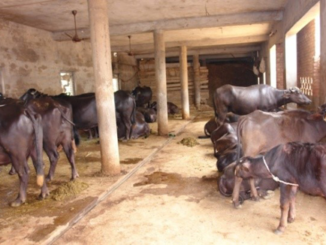
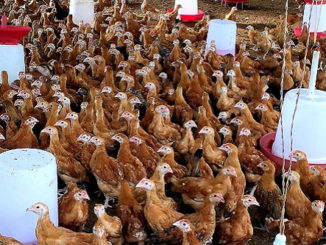
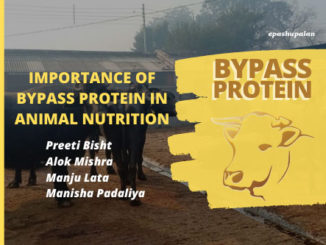

Resourceful.
Really a resourcefull anf informative article.
Very Informative